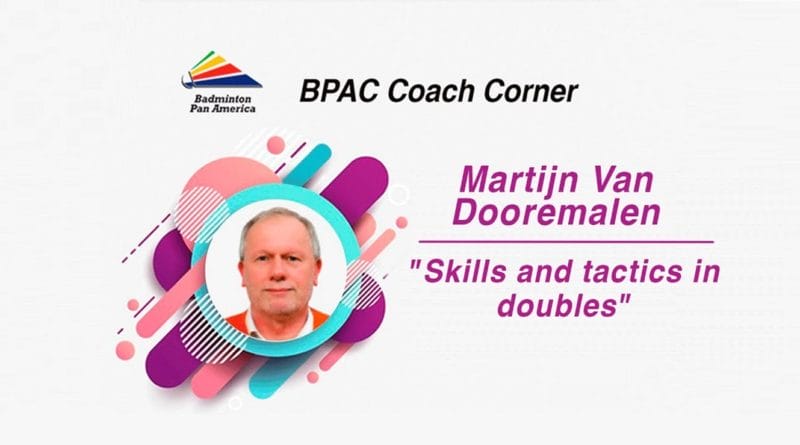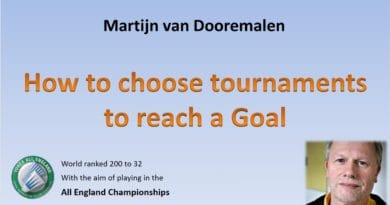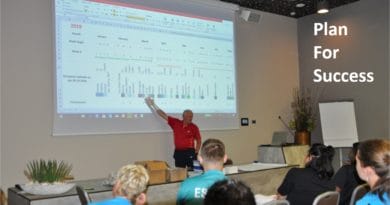Skills and tactics in doubles by Martijn Van Dooremalen
This seminar is from the great series published by the Pan America badminton federation
Its another presentation by Martijn Van Doorelmaland
If you want to see all the posts featuring online seminars click here
Martijn will lead you through his ideas and concepts when introducing doubles to beginner, intermediate and high-performance players. He skillfully describes a step by step approach using key points and lots of court diagrams. Each phase is broken down into 3 stages: Serving – Defence – Attack
If you like a copy of the slides click here
The summary below is mine and based on the points I think are useful reminders for you. If after watching the video you feel that other points should be made please let me know or place a comment at the bottom of this page.
Key points
- Tactical context: as soon as possible, skills should be learnt in a tactical context
- Variations: incorporate uncertainty and freedom of shot/movement choice, within the practice constraints
- Progressions: as soon as skills are part established coaches should seek to progress the practice
- Decision making for all players: ensure as often as possible 3 or 4 players are involved in the practice
- Encourage player initiative throughout all work
- Balance between scoring and preventing scoring: consideration given to these 2 aims
For more information on key points and a summary of the questions go to the end of this post
Beginner Key points
-
- Service :
- Backhand service to the opponents ‘T’ is favoured
- Return of service : include a receiver in most service practice situations
- Tactics : introduce tactical concepts for both receiver and server. Often within the same practice
- Service :
-
- Defensive skills
- Considered an essential, possibly higher than attacking skills at this development stage
- Combine defensive practices should be combined with hitting down from the net (above and level with the net)
- Important to introduce variation into the practice so that both players are developing ..defensive and net player
- Defensive skills
- Attacking skills
- Use smash and drop. Also use the use clear as a weapon at the (esp in LD)
- Use rally type practice where the shuttle is returned by the opponent
- Vary power and placement of smash and drop shot
Intermediate level
-
- Serving
- Introduce flick serve : straight and wide
- Give options to the receiver and also to the servers partner ie the 3rd shot is now required in the practice
- Decision making is very important and should be encourage within all 3 shots and player movements
- Serving
-
- Defensive
- Introduce high lift return
- Practice from different types of smashes .Variation in attack is important
- Defensive
- Attack
- Introduce stick smash and stop drop
- Encourage use of the attacking players partner in practices. net player
High performance players
-
- Serving
- Serving to 4 corners and the opponents body
- Receivers have full variations including the front / mid court ie 6 positions
- Serving
-
- Defensive
- Straight and cross defensive depending on what the player observer in regard to the postion of the attacking pair
- Develop hard and soft replies to opponents front court
- Use 2v1
- Defensive
- Attacking
- Introduce and develop deceptions from the rear court plus jumps, slices, pulled drops shots
- Net .. Variation with fingers and contact on shuttle
Questions
- Attack to the middle .. which of the defenders takes control : MVD suggests that the player on the backhand defensive takes the shot
- In mixed when the man is serving who is responsible for playing the straight return to the side : MVD suggest that the female intercepts or tries to the straight
- Early specialisation of doubles: MVD favoured later specialisations around 16-17/yrs old and to keep doubles players in singles a little longer as there are benefits to playing singles
- Who decides of partnership combinations : Mvd.feels that both players need to see an advantage and positive in a partnership and the coach will work with them. The goal is the creation of a complementary partnership. Don’t forget the physiology aspects of partnerships
- Advice for RH and LH combinations: MVD states that it’s a complex answer, I suggest that you go to time stamp56:00 mins and listen




